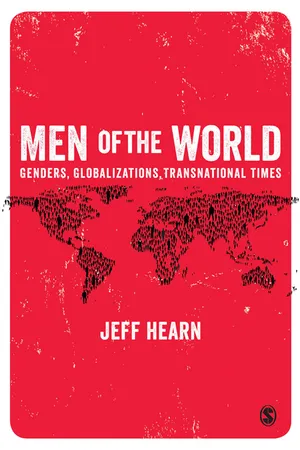Geography
Flows
Flows refer to the movement of people, goods, and ideas across geographical spaces. These movements can be local, regional, or global and can be influenced by factors such as transportation infrastructure, economic policies, and cultural exchange. Understanding flows is important in geography as it helps to explain patterns of migration, trade, and cultural diffusion.
Written by Perlego with AI-assistance
Related key terms
Related key terms
1 of 4
Related key terms
1 of 3
2 Key excerpts on "Flows"
- eBook - ePub
Men of the World
Genders, Globalizations, Transnational Times
- Jeff Hearn(Author)
- 2015(Publication Date)
- SAGE Publications Ltd(Publisher)
7 Processes of Flows (1): Movements, Environments, and MigrationsThis chapter is the first of two chapters focusing on processes of movements and Flows. These clearly concern physical movements of people, as in environmental movements;1 migration and travel; and various kinds of movement of information, ideas, beliefs, images, symbols, religions, ways of thinking and feeling, and representations, most obviously through ICTs. Movements and Flows are also central concerns in national and transnational citizenship, and its intersectional gendering. All these examples need to be considered in relation to ‘men of the world’, in their different locations, in which men are both bound together, homosocially networked, yet geographically and socially apart.Transnationalization takes place through processes of movements and Flows, of numerous types and forms. They are everywhere. They constitute identities, settlements, communities, organizations, wealth, finance, communications, information, images, environments, and so on. Movements and Flows are also movements and Flows of bodies, individual and collective, what might be called moving bodies. Movements and Flows occur over time and place, dispersed in time and place, moving and developing from place to time and over time, framed beyond the agentic, and organized through institutions, organizations and organizings that are both embedded and sedimented. These are in effect the structures – frameworks, framings, controls – of movements, Flows and processes. And then there are the processes, the waves, the characteristic form of movements and Flows. These are especially important in problematizing men. They undermine fixities of men and masculinity, and show their, at times, fictional power and status. This is clear with both the environment and migration. In both these arenas men and masculinity may be powerful, yet potentially destabilized. Migration may mean, though by no means always, relative downward movements in the social status of some men, even when with material gain. Environmental change may threaten livelihoods, and even human survival. - eBook - ePub
New Urban Management: Attracting Value Flows to Branded Hubs
Attracting Value Flows to Branded Hubs
- A. Anttiroiko(Author)
- 2015(Publication Date)
- Palgrave Pivot(Publisher)
frictional Flows or physical Flows are basically of three kinds: (a) freight and material Flows; (b) client Flows, such as tourists, conference visitors and students; and (c) productive actor Flows, such as relocating firms, inflow of skilled and creative people and professionals, as well as low-skilled immigrants (cf. Kostiainen, 1999). These Flows make up two primary realms, both of which are expedited by technological development. Digitalisation changes symbolic, information and monetary Flows, whereas improvements in mobility do the same to material and client Flows (see e.g. Williams & Balàz, 2009).FIGURE 5.1 Illustration of city as the integrator of different types of FlowsTo make sense of the field of Flows, we may consider the fundamental economic roles of people in terms of consumption and production, the classic typology of markets (factor and product markets) and the city as an economic spatio-temporal locus that combines these elements through investment, production, distribution and consumption functions. Such a robust model of the main aspects of economic flow analysis are illustrated in Figure 5.1 .Some of the typologies of Flows are based on contextual analysis of Flows, such as Appadurai’s (2003) five ‘Flowscapes’ – people, technologies, finance, media and ideologies – as the landscape of late modernity. Yet to achieve a scheme that is relevant for local economic development policy, such a typology should be accurate and provide a synthesised approach to Flows. An example of the generic typology of Flows that fulfils this criterion is proposed by Williams and Balàz (2009, 679–680). It is built on four major categories related to regional development: (1) trade, (2) labour migration, (3) capital and (4) knowledge. Similarly, in McKinsey Global Institute’s report on global Flows the main flow categories analysed were goods, services, finance, people and data (Manyika et al., 2014). In DHL Global Connectedness Index 2014, global connectedness of a country or macro-region was defined as their participation in international Flows of trade, capital, information and people. These four pillars were further divided into following components (Ghemawat & Altman, 2014):
Index pages curate the most relevant extracts from our library of academic textbooks. They’ve been created using an in-house natural language model (NLM), each adding context and meaning to key research topics.
Explore more topic indexes
Explore more topic indexes
1 of 6
Explore more topic indexes
1 of 4

